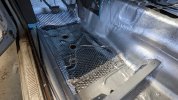JW240
Active Forum User
I know this is a big topic, but like a lot I'm pretty nervous about adding new sound deadening after spending ages removing the original and repairing the results of its failure. Therefore I have decided to leave the floor pans bare for my own piece of mind, however I do need something as its so loud and boomy inside the cabin. Seems to be worse around the rear.
I was therefore thinking dynamt the tunnel, insides of doors, firewall, rear wheel tubs, boot floor and insides of quarter panels. Never used sound deadening or anything before, seems self explanatory though, just don't want to encourage the dreaded rust to start forming.
I was therefore thinking dynamt the tunnel, insides of doors, firewall, rear wheel tubs, boot floor and insides of quarter panels. Never used sound deadening or anything before, seems self explanatory though, just don't want to encourage the dreaded rust to start forming.


